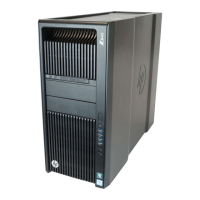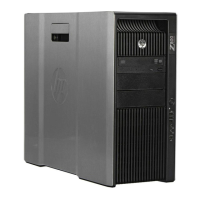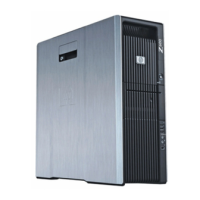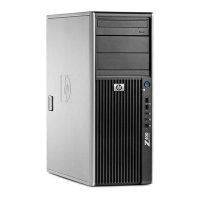18
Technical white paper | HP Z840 Workstation
To add hot spares to an existing volume on the SAS controller:
After creating a volumes consisting of mirrored disks you can optionally add hot spares (up to a maximum of 2 hot spares
on the controller) that will automatically replace a disk that has failed.
a) From the Adapter Properties screen use the Up/Down arrows to select “RAID Properties” and press Enter.
b) Use the Up/Down arrows to select “View Existing Volume” and press Enter.
c) “Manage Volume” will be highlighted. Press Enter.
d) Use the Up/Down arrows to select “Manage Hot Spares” and press Enter.
e) Use the Up/Down/Right/Left arrows navigate to the “Hot Spr” column and line of the desired drive to add and press Space.
f) Press c to commit the changes and use the Up/Down arrows to select “Save changes then exit this menu” on the
next screen and press Enter.
g) You will be returned to the Manage Volume screen. Press Esc until you reach the screen with the “Exit the
Conguration Utility and Reboot” option. Use the Up/Down arrows to select “Exit the Conguration Utility and
Reboot” and press Enter.
2. RAID creation using the SAS-2 Integrated RAID Conguration Utility (SAS2IRCU)
The SAS2IRCU command line utility for creating and managing RAID arrays is available for DOS shell, EFI shell, Windows
command line and a variety of other operating systems. The SAS2IRCU utility is available with the SAS driver package on
hp.com.
Instructions for using SAS2IRCU can be found in “SAS-2 Integrated RAID Conguration Utility (SAS2IRCU) User Guide”,
document DB15-000933-01 which can be downloaded from LSI.
3. RAID array creation using the LSI Logic MegaRAID Storage Manager for LSI
MegaRAID SAS Controllers.
The LSI Logic MegaRAID Storage Manager for LSI MegaRAID SAS Controllers is primarily intended for use with LSI
MegaRAID SAS controller. or additional information on how to use this application, see the documentation and help
menus for the application.
Performance considerations
Power settings
The default “Balanced” and “Power Saver” plans in Windows Power Options may result in power management settings
that may adversely aect performance of your applications. If the workstation is being used for a high demand
application, consider choosing the “High performance” power plan or choose custom settings that better t your use model.
SSDs used in RAID congurations and TRIM support
TRIM keeps track of les that have been deleted but not erased on the drive to improve performance and help extend the
life of the SSD. As the SSD is used, the controller within the SSD distributes data across the available FLASH on the SSD
until all FLASH is used. After the FLASH has been used up, a block erase is required before subsequent writes can occur.
The TRIM command normally frees up memory prior to being needed for the next write. If the TRIM commands are not
sent to the drive and no unerased FLASH is available for writing, the SSD controller must erase a block of memory prior to
writing. This can slow performance in applications that perform a lot of le write and le delete operations. One example
is in compiling code where the compiler generates many intermediate les that then get deleted.
The table below shows which RAID arrays support TRIM:
Controller TRIM supported TRIM not supported
SATA 0, 1
sSATA 0, 1, 10 5
SAS 0, 1, 1E, 10

